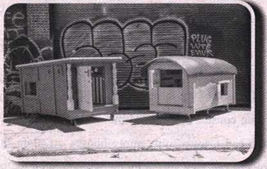题目内容
B

As a sculptor,Gregory Kloehn often felt his sculptures that stayed in one place for years on end,lacked a meaningful purpose. So he decided to channel his artistic energies into creating homes.
Over the years,he built lots of small houses,bars and restaurants from recycled shipping containers. But the thought of doing the same for the homeless never occurred to him. That idea hit in 2013 when a homeless couple in search of a tarp(防水布) ,knocked at his door. While Gregory did not have a tarp,he did have a small wooden structure complete with a water tank and built-in kitchen that he offered them. They were so grateful for his generosity that Gregory decided to build more for other people in similar situations.
Since starting the Homeless Homes Project in 2013,Gregory has donated ten homes to the most needy. The brightly colored houses that are the size of a regular sofa,are not fancy,but they do provide a safe place for the homeless to sleep in.
Gregory often goes hunting for raw materials by digging through dumpsters(垃圾箱) in an industrial area of Oakland. Everything he finds is usable — refrigerator doors become house doors,pizza delivery bags turn into insulators (隔热层) , while washing machine doors often serve as windows. Wheels at the bottom allow the homes to move around easily,while pitched roofs (斜屋顶) help make the shelters rain-proof. Gregory says that each mobile shelter which is built with a team of volunteers,costs between $30-$50 in screws,nails,glue,and the gas that he uses to search for materials.
Like any other project,Gregory has seen his fair share of challenges. The original house which inspired the whole movement was firebombed,while another was stolen. One homeless recipient (接受者) sold his home for $80,which has since been used as a dog house. But those incidents are few and far between. Most are thrilled with their houses. A woman named Wonder calls her new home,which is made from an unwanted picnic table,the best one she has had in five years.
6. Gregory decided to create homes because.
A. he had no house of his own
B. he was inspired by other artists
C. he wanted to become an architect
D. he would like to try something different
7. How did Gregory treat the homeless couple who knocked at his door?
A. He invited them to dinner.
B. He gave them some money.
C. He provided a house for them.
D. He offered them what they wanted.
8. The houses Gregory has donated .
A. are made of high-quality material
B. can move around with their owners
C. are built completely by Gregory himself
D. have refrigerators and washing machines inside
9. What can we learn about the Homeless Homes Project?
A. It receives much support from the public.
B. Its (Jonations are all kept in good condition.
C. It was actually created by a homeless couple.
D. Its donations are unpopular with the homeless.
10. How does Wonder feel about her new home?
A. It needs improving.
B. It truly meets her needs.
C. It isn't worth a penny.
D. It should be sold at a good price.
B篇(兴趣与爱好)
本文是记叙文。文章介绍了用废旧物品为无家可归的人制造移动房子的雕塑家 Gregory Kloehn。
6. D. 推理判断题。由第一段可知, Gregory认为他的雕塑作品始终如一地 呆在一个地方多年缺乏新意,.因此决定把他的艺术创作力转移到建造房子上,故推测他是想尝试新鲜事物。
7. C. 细节理解题。由第二段的.he did have a small wooden structure …that he offered them可知,Gregory把他做的木房子送给了那对无家可归的夫妇。
8. B. —细节理解题。由第三、四段可知,Gregory所赠送的房子都是他和志愿者 们利用可回收的废品做的,这些房子的底部都安装了轮子,便于移动。
9. A. 推理判断题。由倒数第二段的each mobile shelter which is built with a team of volunteers 可知,由 Gregory 发起的 Homeless Homes Project运动得到了志愿者们的大力支持。
10. B. 推理判断题。由最后一段Wonder 说这是她五年来住过的最好的房子可知,这个新房子满足了她的需求。

